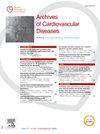线粒体GTPase Miro1在心肌细胞功能和心脏稳态中的作用
IF 2.3
3区 医学
Q2 CARDIAC & CARDIOVASCULAR SYSTEMS
引用次数: 0
摘要
线粒体主要存在于心肌细胞中,其功能障碍已在心血管疾病中被广泛观察到,越来越多地被认为是潜在的治疗靶点。线粒体的功能与其沿着微管移动的能力密切相关,以适应微管的分布、形态和动力学,以响应细胞的需求。线粒体外膜蛋白Miro1是线粒体运动的关键调节因子,通过促进线粒体锚定在微管上运动的运动蛋白/动力蛋白运动。Miro1在心肌细胞中的作用在很大程度上仍然未知。目的在本研究中,我们通过对成年小鼠心肌细胞特异性缺失Miro1来探讨其在心脏中的作用。方法使用心脏特异性他莫昔芬诱导的Cre重组酶破坏成人心脏中的mir1。注射他莫昔芬2周和5周后,通过超声心动图、综合形态学评估、代谢分析和转录组学分析对小鼠进行表征。结果连续超声心动图(包括组织多普勒成像)显示,Miro1的破坏导致左心室功能受损,收缩力降低,随后发展为扩张型心肌病。心肌细胞的细胞结构发生改变,线粒体结构发生改变。有趣的是,这些改变与纤维化增加有关(通过天狼星红染色评估)。这些功能和结构缺陷发生在心脏基因表达程序的早期改变之前:心脏α-肌动蛋白、肌酸激酶和钙处理基因的mRNA水平显著降低,而应激诱导基因(如β -肌球蛋白重链基因、心房利钠因子和脑利钠肽)的mRNA水平升高。结论这些结果强调了mir1在维持心脏稳态和功能中的重要性。本文章由计算机程序翻译,如有差异,请以英文原文为准。
Role of Miro1, the mitochondrial Rho GTPase, in cardiomyocyte function and heart homeostasis
Introduction
Mitochondria, which are mainly abundant in cardiomyocytes and whose dysfunction has been widely observed in cardiovascular disease, are increasingly being considered as potential therapeutic targets. The function of mitochondria is closely linked to their ability to move along microtubules to adapt their distribution, morphology and dynamics in response to the demands of the cell. The outer mitochondrial membrane protein Miro1 is a key regulator of mitochondrial motility by promoting the anchorage of mitochondria to the kinesin/dynein motor of the microtubules on which they move. The role of Miro1 in cardiomyocytes remains largely unknown.
Objective
In this study, we explored the role of Miro1 in the heart using cardiomyocyte-specific deletion of Miro1 in adult mice.
Method
We disrupted Miro1 in the adult heart using a heart-specific tamoxifen-inducible Cre recombinase. Two and five weeks after tamoxifen injection, mice were characterized via echocardiography, comprehensive morphological evaluation, metabolic analysis, and transcriptomic profiling.
Results
The disruption of Miro1 led to impaired left ventricular function with reduced contractility, subsequently progressing to dilated cardiomyopathy, as demonstrated by serial echocardiography, including tissue Doppler imaging. The cytoarchitecture of cardiomyocytes was altered and display altered mitochondrial architecture. Interestingly, these alterations were associated with an increased fibrosis (assessed by Sirius red staining). These functional and structural defects were preceded by early alterations in the cardiac gene expression program: major decreases in mRNA levels for cardiac α-actin, muscle creatine kinase, and calcium-handling genes and increases in mRNA levels for stress-induced genes such as beta-myosin heavy chain genes, atrial natriuretic factor and brain natriuretic peptide.
Conclusion
These results highlight the importance of Miro1 in the maintenance of heart homeostasis and function.
求助全文
通过发布文献求助,成功后即可免费获取论文全文。
去求助
来源期刊

Archives of Cardiovascular Diseases
医学-心血管系统
CiteScore
4.40
自引率
6.70%
发文量
87
审稿时长
34 days
期刊介绍:
The Journal publishes original peer-reviewed clinical and research articles, epidemiological studies, new methodological clinical approaches, review articles and editorials. Topics covered include coronary artery and valve diseases, interventional and pediatric cardiology, cardiovascular surgery, cardiomyopathy and heart failure, arrhythmias and stimulation, cardiovascular imaging, vascular medicine and hypertension, epidemiology and risk factors, and large multicenter studies. Archives of Cardiovascular Diseases also publishes abstracts of papers presented at the annual sessions of the Journées Européennes de la Société Française de Cardiologie and the guidelines edited by the French Society of Cardiology.
 求助内容:
求助内容: 应助结果提醒方式:
应助结果提醒方式:


